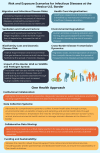Zoonosis: social and environmental connections in the Mexico-United States border region
- PMID: 39780242
- PMCID: PMC11715514
- DOI: 10.1186/s42522-024-00120-w
Zoonosis: social and environmental connections in the Mexico-United States border region
Abstract
The emerging risks facing humanity have highlighted the need to address and prevent challenges through multilateral preventive strategies. The Mexico-United States (US) border is a region with great biological biodiversity and both countries shared a similar history and intense socioeconomic, and cultural interrelationships. Also, it has an extraordinary ecological contrast, resulting in an enormous biological diversity in a broad Nearctic-Neotropical transition zone. This dynamic region has important disparities due to the lack of bilateral strategies to face emerging issues (e.g., infectious diseases) in an integrated and holistic approach. In this context, we describe the various socio-ecosystemic contexts of the shared border and present different diseases transmitted, and different zoonoses that affect ecosystemic public health that must be addressed under collaborative schemes that can develop preventive policies under the One Health approach with emphasis on the Mexican zone. We describe the social determinants of health issues for the border, but we add ecological contexts infrequently studied in classical epidemiological approaches. Strategies towards One Health require international and multidisciplinary approaches that strengthen diagnostic capabilities, recognizing social, and environmental challenges. Recognizing these aspects will allow the establishment of joint monitoring, prevention, and mitigation strategies with benefits for both countries.
Keywords: Disease transmission; Environment degradation; Marginalization; Migration; One Health approach.
© 2024. The Author(s).
Conflict of interest statement
Declarations. Ethics approval and consent to participate: Not applicable. Consent for publication: Not applicable. Competing interests: The authors declare that they have no competing interests.
Figures

Similar articles
-
The 2023 Latin America report of the Lancet Countdown on health and climate change: the imperative for health-centred climate-resilient development.Lancet Reg Health Am. 2024 Apr 23;33:100746. doi: 10.1016/j.lana.2024.100746. eCollection 2024 May. Lancet Reg Health Am. 2024. PMID: 38800647 Free PMC article. Review.
-
The political and socioeconomic context of legal and illegal Mexican migration to the United States (1942-1984).Int Migr. 1988 Mar;26(1):95-107. doi: 10.1111/j.1468-2435.1988.tb00613.x. Int Migr. 1988. PMID: 12281024
-
Barriers to sexual and reproductive care among cisgender, heterosexual and LGBTQIA + adolescents in the border region: provider and adolescent perspectives.Reprod Health. 2022 Apr 12;19(1):93. doi: 10.1186/s12978-022-01394-x. Reprod Health. 2022. PMID: 35414000 Free PMC article.
-
The Minderoo-Monaco Commission on Plastics and Human Health.Ann Glob Health. 2023 Mar 21;89(1):23. doi: 10.5334/aogh.4056. eCollection 2023. Ann Glob Health. 2023. PMID: 36969097 Free PMC article. Review.
-
The future of Cochrane Neonatal.Early Hum Dev. 2020 Nov;150:105191. doi: 10.1016/j.earlhumdev.2020.105191. Epub 2020 Sep 12. Early Hum Dev. 2020. PMID: 33036834
References
-
- USEPA and SEMARNAT United States Environmental Protection Agency. and SEMARNAT, Border 2020: U.S.–Mexico Environmental Program. 2020.
-
- Feigenberg F. Fenced out: the impact of Border Construction on US-Mexico Migration. Am Economic Journal: Appl Econ. 2020;12(3):106–39.
-
- U.S. Customs and Border Protection. https://www.cbp.gov/newsroom/stats/cbp-public-data-portal. 2023. [accessed December 10, 2023].
-
- Valle VM, Gandoy WL, Valenzuela KA. (2020) Ventanillas de Salud: Defeating challenges in healthcare access for Mexican immigrants in the United States. Estudios Fronterizos. 2020;21: 1–27; 10.21670/ref.2001043
-
- Velasco Ortiz L, Contreras OF. The Border as a life experience: identities, asymmetry and Border Crossing between Mexico and the United States. Frontera Norte. 2014;26:37–56.
Publication types
Grants and funding
LinkOut - more resources
Full Text Sources
